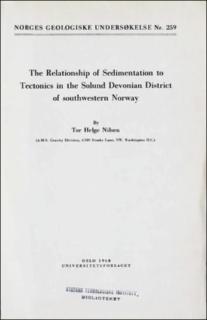The relationship of sedimentation to tectonics in the Solund Devonian District of southwestern Norway.
Journal article

Åpne
Permanent lenke
https://hdl.handle.net/11250/2674905Utgivelsesdato
1968Metadata
Vis full innførselSamlinger
- Artikler [1064]
Sammendrag
The Solund district of southwestern Norway contains a maximum preserved stratigraphic thickness of 5,200 meters of coarse conglomerate with less amounts of intercalated sandstone. The deposits are thought to be Middle Devonian because of lithostratigraphic similarity to nearby basins containing Devonian plant and fish remains. The sediments are thought to represent post-Caledonian humid alluvial fan deposits analogues to those in the Triassic Newark basins of the Appalachian Mountains. Devonian block faulting and graben formation resulted in the deposition of alluvial sediments in basins adjacent to contemporaneosly uplifting highlands. The present structural basin of the Solund district, about 800 square kilometers in area, preserves part of a large, northeast-southwest-striking coalsced fan complex. The coarse Devonian classtics were deposited on a topographically irregular basement of Cambro-Silurian rocks. Local basal sedimentary breccias composed of angular fragments of immediately underlying basement rocks are found in topographic areas of the basement. The basement rocks formed part of the Caledonian eugeosynclinal area. With the most common rock types being metamorphosed quartzo-feldspathic wackes and siltstones, feldspathic quartzites, pillowed and layered metabasalts, and intrusive gabbros and granodiorites.
